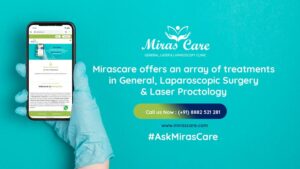Laser Excision of Sentinel Tag with Fissure and Haemorrhoids
According to Dr. Mir Asif, a renowned proctologist and laparoscopic surgeon in Gurgaon, laser excision is a minimally invasive surgical technique employed for the treatment of certain anal disorders such as sentinel tags, fissures, anal fistulas, and haemorrhoids. In this surgical video, you can see that I am utilising laser treatment, a concentrated beam of light to vaporise the afflicted tissue. This approach minimises discomfort, bleeding, and recovery time in comparison to conventional surgical procedures for patients.

Understanding the different types of conditions
1. Sentinel tag: A diminutive, osseous proliferation that frequently forms in close proximity to the anus, commonly seen in conjunction with an anal fissure.
2. Anal Fissure: A small rupture or incision in the anal canal’s epithelial lining, frequently resulting in discomfort and blood loss.
3. Haemorrhoids: Enlarged veins in the anus and rectum, leading to pain and internal bleeding. The rectum is the terminal segment of the large intestine that articulates with the anus, the orifice at the end of the digestive tract via which feces exit the body. Furthermore, these structures also include anal cushions, among several others. Anal cushions housed within the anal canal are typically located at the 3, 7, and 11 o’clock positions.
Advantages of Laser Excision: Why We Use It Frequently
1. Laser technology is very precise, resulting in minimal pain and bleeding and minimising postoperative discomfort by causing less injury to surrounding tissues in the patient.
2. Faster recovery: Within a few days, patients frequently resume their daily activities.
3. Decreased risk of scarring: Laser excision can reduce the risk of scarring, thereby enhancing cosmetic results.
4. Outpatient procedure: Laser treatment often requires no overnight hospital stay.
During Procedure Overview
1. Preparation: You need to typically be sedated or anaesthetised for the procedure after being instructed by our medical team.
2. Laser application: As you can see in this surgical video, the laser beam vaporises the affected tissue during the procedure without seriously harming the surrounding areas.
3. Closure: If necessary, we may close the area with sutures after the surgery or allow it to heal naturally. In this video, we also used ICE to alleviate the effects of laser heating.
Postoperative Care
1. Pain management: After the surgery, we prescribed over-the-counter or prescription pain medications to help manage discomfort.
2. Hygiene: Proper hygiene practices are the most important thing to keep in mind. Proper hygiene practices are essential to prevent infection and promote healing.
3. Diet: As per our suggestion, a fibre-rich diet can help prevent constipation and strain on the anal area.
It’s important to consult with a qualified healthcare professional who is majorly experienced in laser surgery to determine if laser excision is the right treatment for your specific condition. They can assess your symptoms, medical history, and overall health to provide personalised recommendations.



